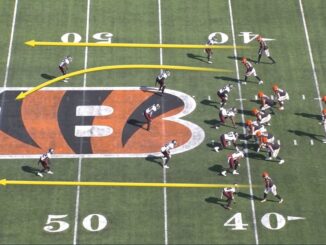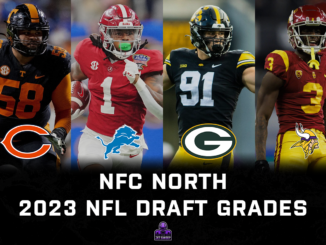
The Vikings surprised many with the level of dominance over the Packers in Week 1. The star of the show was of course Justin Jefferson. After setting an NFL record for receiving yards in his first two seasons, he torched the Green Bay defense in the Week 1 opener. Jefferson finished the game with nine catches for a career-high 184 yards and two touchdowns.
What was noticeable throughout the game was the multitude of ways in which Minnesota was using Jefferson and how they were scheming up easy opportunities for their star receiver. Jefferson’s role in this offense looks set to be more varied than it ever was under Mike Zimmer. Judging by the results of this game that is something that should terrify the rest of the league. So how exactly did the Vikings manage to make a highly regarded Packers defense look like Swiss cheese? Let’s dive into the film and find out.
Jefferson puts on a clinic
Jefferson’s first play wasn’t particularly special from a scheme perspective. Instead, he just put on a clinic and showed why he’s one of the best in the business. On this play the Vikings have Jefferson aligned as the Z receiver at the bottom of the screen. The Packers are in Cover 1, with Eric Stokes (#21) aligned across from Jefferson in press man coverage.
Jefferson beats his man almost instantly, utilising a jab step with his right foot. Stokes knows that he can’t be beaten outside, so he flips his hips to the boundary. This allows Jefferson to cut back inside and win to Stokes’ inside shoulder. Jefferson then manipulates Stokes with a subtle head fake before breaking off his route with plenty of separation. This is just outstanding receiver play from start to finish.
The weak side choice route
This is where things start getting interesting. Under Mike Zimmer, Jefferson played a fairly static role in an old school offense. If this game is anything to go by that looks set to change in 2022. O’Connell was offensive coordinator for the Rams last season and helped Cooper Kupp to his historic season. On this play he has Jefferson running one of the staples of Kupp’s route tree – the weak side choice route.
The choice route, as the name suggests, gives Jefferson the freedom to decide how to run it. He has the option to break in or out, with his decision based on the technique and positioning of the defenders in front of him. In this instance he is aligned in the slot on the weak side of the formation opposite linebacker Quay Walker (#7). Walker is playing with heavy inside leverage, so Jefferson breaks his route out towards the sideline. He ends up wide open and picks up an extra 15 yards after the catch.
Red zone motion
O’Connell is clearly keen to scheme up easy opportunities for his star receiver. This play is another way he will look to do it. The Vikings are at the five-yard line and know that defenses tend to play a lot more man coverage in the red zone. For years we have seen smart play callers take advantage of this with the use of motion – the Packers themselves were experts at it with Davante Adams.
On this play the Packers are actually playing some form of man-match coverage, with defenders tasked with passing off receivers based on the routes they run. These coverages require perfect communication between the various defenders, but Jefferson’s motion causes havoc with that. The two defenders at the bottom of the screen focus their attention on Adam Thielen, leaving Jefferson wide open for his first touchdown of the game.
Going deep
What makes Jefferson such a special receiver is that he has the speed to win as a legitimate deep threat. On this play he is once again aligned as the slot receiver on the weak side of the formation. The Vikings have tasked him with running a post route as the deepest receiver on the play. In theory the Packers should have this covered. They are playing quarters, with the two safeties able to effectively bracket Jefferson as he goes deep.
In reality it doesn’t work like that though. Jefferson predictably does an excellent job of manipulating defenders throughout the route. He uses a jab stap with his left foot to fake like he is running a corner route. This terrifies Packers safety Darnell Savage (#26) who has no help to the outside. It forces him to flip his hips and turn his back on Jefferson. Adrian Amos (#31) then gets caught flat footed, giving Jefferson acres of room to make the catch. Once again, he maximises the opportunity for YAC, picking up an additional 20 yards.
The stack and choice route
One thing we saw frequently from the Vikings in this game was the use of stack formations. This is where two receivers line up close together, with one effectively behind the other. This prevents defenses from playing press coverage and guarantees a free release to the rear of the stack. It also makes life harder for the defense if they are playing man coverage, as the stack presents plenty of opportunities for running pick plays.
Once again, the play call is perfect for Minnesota. Jefferson is aligned at the rear of the stack to the bottom of the screen. The Packers are playing a split field coverage, with three defenders covering the two receievrs. With this play call, Jaire Alexander (#23) is responsible for carrying the first vertical receiver, with help from the safety over the top. Rasul Douglas (#29) then takes responsibility for any underneath routes. Jefferson is running another choice route and the depth of the Packers’ corners sees him wide open yet again.
The “double over”
Great players can get open, but good play callers make their life easier. The design of this play is outstanding and the credit for this should go as much to O’Connell as it does to Kirk Cousins and Justin Jefferson. This time we see Jefferson lined up as the X receiver to the bottom of the screen. Both he and Adam Thielen are tasked with running over routes from opposite sides of the field, with KJ Osborn running a deep post.
The play works to perfection. The Packers are playing Cover 3, so Jaire Alexander (#23) passes Jefferson off once he cuts towards the middle of the field. This will allow him to take responsibility of Thielen, who is running towards his side of the field. The problem is that the other boundary corner, in this case Eric Stokes (#21), is preoccupied with Osborn on the post route. This leaves nobody to cover Jefferson, who is once again in acres of space for another big completion and a touchdown.
Yet more motion
This play is another excellent example of the Vikings use of motion. Whereas the play at the goal line was to scheme a free release, this play is to scheme up a favourable matchup. The Packers are playing a five-man front, with just one off-ball linebacker on the field. The Vikings initially line up in a 3×1 formation, with Jefferson as the inside receiver in the trips. He then motions across the formation, presenting a 2×2 look.
This motion changes everything. Because of the formation and personnel the Packers are employing, Preston Smith is forced to shift out and cover the slot to the bottom of the screen. That matches Smith, a 6’5″ and 265 lbs edge rusher, with Jefferson. This is as big of a mismatch as you are likely to see on an NFL field and Jefferson predictably takes advantage. He expertly sets up Smith at the top of his route before breaking towards the boundary and making the catch.
Into the backfield
The result of this play isn’t as impressive as the others. In fact, Jefferson ended up being tackled for no gain. What it does show though is the multitude of ways in which O’Connell is planning on using him this season. Jefferson starts off as the slot receiver in a trips formation to the left, before motioning into the backfield. He then becomes the de facto running back in a pistol formation. This kind of thing is simple, but it puts added strain on defenses who have to adjust. It also guarantees once again that Jefferson gets a free release and gets his hands on the ball in plenty of space.
The return of the “double over”
Jefferson’s ninth and final reception came on another “double over” play. The Vikings benefit from some poor communication and confusion in the Packers’ secondary, with the defense is clearly not prepared at the snap. This time the two over routes cause a different problem for the Packers. With the secondary playing some form of man-match coverage, the two over routes effectively act as a pick play, with KJ Osborn blocking the path of the safety matched up on Jefferson. Once again, he is wide open. If not for some poor ball placement he’d have had chance to create after the catch too.


